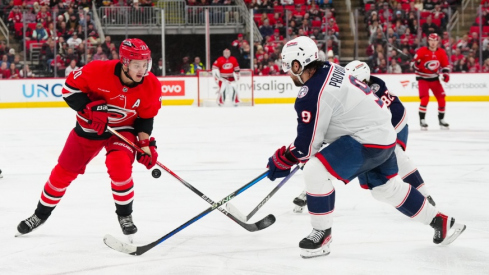Last week, I debated whether the Toronto Maple Leafs have a legitimate home-ice advantage in the qualifying round against the Columbus Blue Jackets.
I wasn't sure there was much of one, to begin with, and the more I've thought about it, the more convinced I am that I posed the wrong question. Home ice likely won't be the reason the Maple Leafs (or Edmonton Oilers) win or the Blue Jackets (or Chicago Blackhawks) lose.
The more significant question is, if not home ice, what will determine the winner of this series? And I think I found the answer: which team scores first.
The Maple Leafs record when scoring first in 2019-20 was 24-5-2. That is to say, while they're even better at home (11-1-1) than on the road (13-4-1), they're a damn strong team when they strike first. Conversely, like most teams in the NHL, the Maple Leafs struggle to find themselves in the win column after surrendering the first goal. Toronto's record when their opponents score first is 12-20-7.
It's a similar story for Columbus. When the Blue Jackets score first, their record this past season was 24-5-7, eerily similar to that of Toronto. Again, when the opponent pots the first goal, the team is far more mediocre: 9-17-8. Coincidentally, the Blue Jackets fare better when giving up the first goal on the road (a respectable 6-8-6) vs home (3-9-2).
Coaches often talk about playing a 'complete game' or giving 'a full 60-minute effort'. But the truth is, it's a real titanic struggle (real Cincinnati Reds fans will know) to win games in the NHL when the other team strikes first. For starters, the game itself looks different from the perspective of a trailing (or leading) team. We call these "score effects".
We've known about score effects for years. The premise is simple. From a Hockey Graphs post from 2014. Generally speaking, "teams with a lead will go into a “defensive shell” and purposely withdraw from the possession battle to preserve their score." In February, Hockeyviz's Micah Blake McCurdy presented on 'Score Sequencing' at CBJHAC. He found that:
"One constant of NHL hockey is that teams that are losing, on average, dominate play. They have the puck more, they take more shots, they score more goals, even though they usually still lose."
So basically, what we have here is the reality that trailing teams generate more possession, shots, and goals, which leads to the illusion that trailing teams come back to win with reasonable frequency. Except they don't. We see clear as day that scoring first overwhelmingly leads to more wins.
Teams with a lead play inherently different than their losing counterparts. They play not to lose. They don't take as many chances. They are reluctant to activate their defense. Their aggressive forecheck becomes less pronounced. Their breakout tactics become risk-averse. Conversely, teams trailing (this exacerbates with a larger deficit) play with a vastly different approach, because they have nothing to lose.
But even so, the data is clear that scoring first leads to more success in the wins column. The Blue Jackets, a strong defensive team with limited offensive firepower, is the exact foil to the Maple Leafs, who boast some of the most dangerous weapons in the league.
Last year serves as a perfect example. The Blue Jackets scored first in three of the four games in the sweep over the Tampa Bay Lightning, but struck first just once in their six-game series loss to the Boston Bruins. Put more succinctly, the Blue Jackets went 2-4 in the playoffs last season after giving up the first goal, and went 4-0 when scoring first.
Home-ice advantage won't make the difference in the qualifying round series. Scoring first will.


